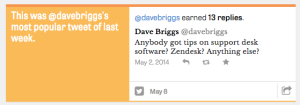
I worry about backups. Do you worry about backups?
The best way to have backups is to ensure you have three copies of everything important and one of those ought to be somewhere other than where your computers are kept. These days, that means the cloud.
I have a fairly standard Seagate 3TB external hard drive connected to the somewhat old and crumbly iMac on my desk. This machine worries me more than any, largely because it has our archive of family digital photos on it, going back some ten years. I use Time Machine on the mac to ensure it takes regular backups automatically, which sorts out the local copy.
For cloud backup, I chose Backblaze which is a great little cloud backup service which gives you unlimited space to backup your macs or PCs, at the remarkable cost of $5 a month per computer. It runs in the background keeping everything up to date without me needing to worry about it.
Of course a lot of my working documents are stored in Dropbox, which means I have a further copy of them. But for those big libraries of thousands of priceless digital photos, the combination of automated local backup to a hard disk and the cloud storage offered by Backblaze seems to be working ok for me.




